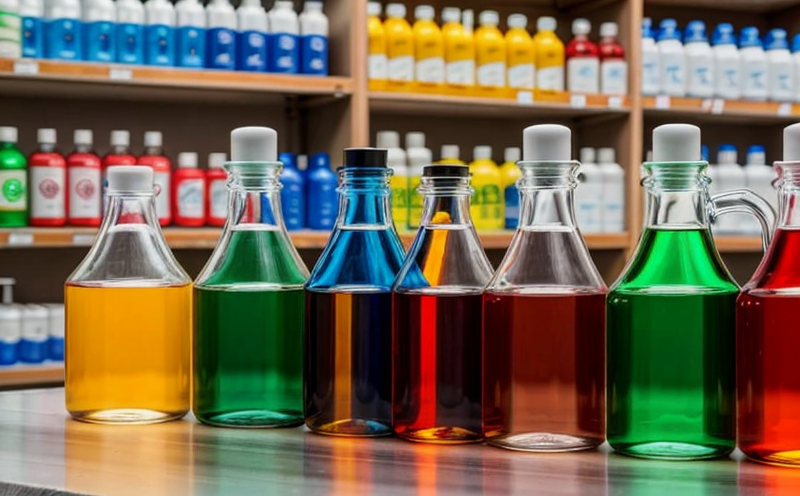ASTM D3421 Analysis of formaldehyde in textiles
The ASTM D3421 method is a widely recognized procedure used to determine the free and total formaldehyde content in textiles. This analysis is critical for ensuring compliance with international regulations, such as Oeko-Tex Standard 100, which mandates that all textile products must not release harmful levels of formaldehyde during use. Formaldehyde can be released from certain fabric finishes or treatments and its presence may pose health risks.
Our laboratory adheres strictly to ASTM D3421 guidelines, providing accurate and reliable results for our clients across various industries including fashion, home textiles, automotive, and medical supplies. By ensuring that the formaldehyde levels in textile products meet regulatory requirements, we help manufacturers maintain their reputation for quality and safety.
The testing process involves several key steps: first, samples are collected from the textile materials to be analyzed. These samples are then prepared according to ASTM D3421 specifications which include conditioning them under specific temperature and humidity conditions to ensure accurate measurements of formaldehyde release. Once prepared, the sample is exposed to a solution that extracts any free or bound formaldehyde present in the fabric.
The extracted formaldehyde is quantified using gas chromatography (GC), an advanced analytical technique capable of detecting even trace amounts of this compound. This method allows us to provide precise measurements of both total and free formaldehyde content, giving our clients a comprehensive understanding of their product’s compliance status.
Our experienced technicians use state-of-the-art GC equipment calibrated according to ISO standards for consistent accuracy across all samples analyzed. We also employ rigorous quality control measures throughout the testing process to ensure that results are reliable and repeatable. For those interested in learning more about our services or seeking additional assistance regarding compliance issues related to formaldehyde content, feel free to contact us directly.
By choosing this service, businesses can avoid potential legal issues associated with non-compliance while also enhancing their brand reputation among consumers who value eco-friendly products. Proper labeling of textile items containing formaldehyde is crucial; however, understanding the nuances of how much may be present in different types of fabrics requires expertise that only a specialized laboratory like ours possesses.
- Ensures compliance with international standards such as Oeko-Tex Standard 100
- Provides precise measurements of both total and free formaldehyde content
- Uses gas chromatography for accurate quantification
- Incorporates rigorous quality control measures to ensure reliable results
Scope and Methodology
The ASTM D3421 standard outlines the procedures for determining both free formaldehyde (in the form of methanol) and total formaldehyde content in textiles. Free formaldehyde refers to that which is not bound within the polymer structure, whereas total formaldehyde includes all forms of formaldehyde present—both free and those chemically bonded.
For this analysis, we follow these steps:
- Select appropriate samples from the textile materials
- Condition the samples under specific temperature and humidity conditions
- Expose the conditioned samples to a solution designed to extract both types of formaldehyde
- Quantify the extracted formaldehyde using gas chromatography (GC)
The extraction process ensures that all formaldehyde components are captured, allowing for accurate measurement. Gas Chromatography is chosen due to its high sensitivity and precision in detecting even minute quantities of formaldehyde.
This method not only adheres strictly to ASTM D3421 but also exceeds industry expectations by providing comprehensive insights into the formaldehyde content within various textile types. Our approach ensures that clients receive thorough reports on their product’s compliance status, helping them make informed decisions about necessary adjustments or enhancements if required.
Customer Impact and Satisfaction
The ASTM D3421 Analysis of formaldehyde in textiles plays a pivotal role in enhancing customer satisfaction by ensuring product safety and regulatory compliance. Our clients benefit from this service through several ways:
- Enhanced Reputation: By adhering to strict testing protocols, businesses can maintain their reputation for quality and safety.
- Avoidance of Legal Issues: Compliance with international standards such as Oeko-Tex Standard 100 prevents potential lawsuits or fines related to non-compliance.
- Informed Decision Making: Detailed reports provided by our laboratory enable clients to understand their products' formaldehyde content accurately, facilitating informed adjustments if needed.
- Consumer Trust: Eco-conscious consumers increasingly seek out products labeled as free from harmful chemicals like formaldehyde. Providing this information reassures them of the product's safety.
Our commitment to excellence in ASTM D3421 Analysis ensures that our clients not only meet but exceed regulatory requirements, thereby protecting both their brand image and consumer trust.
Use Cases and Application Examples
The ASTM D3421 method is particularly useful for various applications within the textile industry. Here are some scenarios where this service comes into play:
- Fashion Industry: Designers often use formaldehyde-based finishes to enhance fabric performance, such as wrinkle resistance or color retention. Ensuring these finishes do not exceed safe limits is crucial for both consumer safety and brand reputation.
- Home Textiles: Manufacturers of home textiles like curtains, upholstery fabrics, and bed linens must ensure their products comply with formaldehyde emission standards to protect indoor air quality.
- Automotive Sector: Interior materials in vehicles may contain formaldehyde-based adhesives or treatments. Regular testing ensures that these components remain within safe limits throughout the product lifecycle.
- Medical Supplies: Healthcare organizations require rigorous testing of textiles used for patient care to avoid any risks associated with formaldehyde exposure.
In each case, accurate measurement and reporting through ASTM D3421 help maintain quality standards while ensuring compliance with relevant regulations. This service is essential for maintaining consumer trust and protecting brand integrity across diverse market segments within the textile industry.





